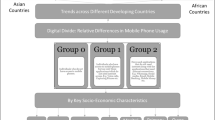Abstract
The social history of the mobile telephone involves both the history of technological development and an account of changing social and political frameworks into which the new technological developments become integrated. The technological innovations of mobile telephony were established from the 1940s, but it was not until the 1990s that adoption took off. It has been claimed that the mobile telephone revolution can be explained by changes in the way communication happens through social networks, away from old hierarchical forms. Several unique communicative and behavioural patterns have emerged in countries with mass use of the mobile telephone, including texting (SMS) and the development of new social norms. Nevertheless there is still huge global variation in use and development, and more research needs to be conducted which responds to very local patterns of use and reuse.
Similar content being viewed by others
References
Agar J: ‘Constant Touch: A Global History of the Mobile Phone’, Icon Books, Cambridge (2003).
ITU: ‘World Telecommunications Development Report: reinventing telecoms’, (2002).
ITU: ‘Trends in Telecommunication Reform: effective regulation’, (2002).
Mobile Operators Association-http://www.mobilemastinfo.com/ information/history.htm
Roos J P: ‘Sociology of cellular telephone: the Nordic model’, Telecommunications Policy, 17, No 6 (August 1993).
Fischer C: ‘America Calling: A Social History of the Telephone to 1940’, University of CA Press (1992).
Geser H: ‘Towards a sociological theory of the mobile phone’, (2002)-http://www.socio.ch/mobile/t_geser1.htm
Churchill E and Wakeford N: ‘Collaborative Work on the Move’, in Brown B, Green N and Harper R (Eds): ‘Wireless World’, Springer Verlag (2001).
Haddon L: ‘The Social Consequences of Mobile Telephony’, Framing, Oslo (2000).
Guardian unlimited (28 March 2003)-http://www.guardian.co.uk/
Rautiainen P: ‘Mobile communication of children and teenagers’, Case, Finland, Tampere (1997-2000)-http://www.telenor.no/
Plant S: ‘On the mobile: the effects of mobile telephones on social and individual life’, (2000)-http:/www.motorola.com/mot/documents/ 0,1028,333,00pdf
‘she’ magazine-http://www.she.co.uk/
BBC World Service report (2001)-http://www.bbc.co.uk/ worldservice/
Townsend A M: ‘Life in real-time city: mobile telephones and urban metabolism’, Journal of Urban Technology, 7, No 2, pp 85-104 (2000).
Ling R: ‘Traditional and fixed and mobile telephony for social networking among Norwegian parents’, in Elstrom L (Ed): ‘Human Factors in Telecommunication’, 17th International Symposium, pp 209-256 (1999).
Lacohée H and Anderson B: ‘Interacting with the telephone’, in Kraut R and Monk A (Eds): ‘Home Use of Information and Communications Technology’, Special Issue of the International Journal of Human-Computer Studies, 54, No 5, pp 665-699 (May 2001).
Chihara M: ‘Lying on the go’, Boston Phoenix (16 March 2000)-http://www.bostonphoenix.com/
Stewart Committee Report-http://www.iegmp.org.uk/
Sir William Stewart, Chairman IEGMP (April 2002)-http:// www.iegmp.org.uk/report/announcement.htm
Wireless News Factor-http://www.wirelessnewsfactor.co/perl/ story/7311.html
Wired-http://www.wired.com/news/wireless/0,1382,52363,00. html
vnunet-http://www.vnunet.com/News/1131965
BBC-http://www.news.bbc.co.uk/
Chapman S: ‘Lifesavers and cellular samaritians: emergency use of cellular (mobile) phones in Australia’ (1998)-http:// www.amta.org.au/files/issues/pdfs/emergency.pdf
Office for National Statistics: ‘Drug use, smoking and drinking among teenagers in 1999’, London, ONS (2000).
Charlton A and Bates C: ‘Decline in teenage smoking with rise in mobile phone ownership: hypothesis’, British Medical Journal, 321, p 1155 (200).
Fortunati L: ‘The mobile phone: new social categories and relations’, University of Trieste (2000)-http://www.telenor.no.fou/prosjekter/ Fremtidens_Brukere/seminarer/mobilpresentasjoner/
New York Times (4 August 2001)-http://www.nytimes.com/
Thomson and Craighead-http://www.thomson-craighead.ne
Author information
Authors and Affiliations
About this article
Cite this article
Lacohée, H., Wakeford, N. & Pearson, I. A Social History of the Mobile Telephone with a View of its Future. BT Technology Journal 21, 203–211 (2003). https://doi.org/10.1023/A:1025187821567
Issue Date:
DOI: https://doi.org/10.1023/A:1025187821567




